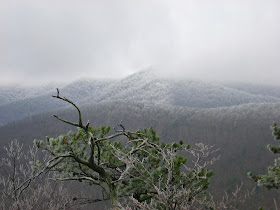 |
| Twin Falls on Overall Run |
Difficulty: Moderate, due to elevation gain and stream crossing
Access: Trailhead off Skyline Drive, Shenandoah National Park entrance fee required
The hike to Overall Run Falls is one of my favorites in Shenandoah. While much of the hike itself is nondescript and follows the undulating woodlands along the crest, the last segment of the trail is spectacular, featuring a steep descent into the rocky gorge of the Overall Run with two waterfalls, the pretty Twin Falls and Big Falls, the tallest waterfall in Shenandoah.
My trip to Overall Run Falls was my first trip to the North District of the park. I've always had trouble motivating myself to visit this part of the park, since it's about a two hour drive from Charlottesville, but as I was home home for winter break and Thornton Gap is the nearest entrance to home home, I figured I might finally make the journey to the North District. I hiked with my family on a fairly warm Christmas Eve.
We entered the park through the Thornton Gap entrance and stopped at Thornton Hollow and Rattlesnake Point Overlooks before reaching the trailhead, which was north a small, unmarked parking lot just south of the Hogback Overlook, at around mile 20 of the Drive.
The trail started from the Blue Ridge crest and follows the AT south to a junction with the Tuscarora-Overall Trail. We followed that trail to the right (west) and began descending from the crest. We stayed on this trail and followed it down to Twin Falls, passing through gentle wooded mountain slopes until passing the junction for the trail toward Mathews Arm.
Abruptly, the landscape changed: the gentle upper regions of the Blue Ridge ended and we began a descent down the steep side of the mountain. Not long into the descent, we came upon Twin Falls, a very pretty 29-foot tall waterfall on Overall Run and a good lunch spot.
Past Twin Falls, the trail continued to drop, with Overall Run making numerous small falls to the left. As the trail switchbacked downhill, the views suddenly opened up: before us was a view of the entire hollow. A final descent put us at a rocky viewpoint high above Overall Run's gorge, with a good view of 93-foot tall Big Falls, the tallest falls in the park.
Like Twin Falls further down, Big Falls is carved into Catocin greenstone. The rocky cliffs of the Overall Run Gorge here are some of the most prominent exposed greenstone areas in the park; the uneven erosion of the greenstone makes the craggy scenery here some of the best in the park.
From the viewpoint, we also had a view out toward Shenandoah Valley and Massanutten Mountain.
While it's possible to return on the Tuscarora-Overall trail, we chose to make a loop by incorporating part of the Traces Trail into our hike. Hiking a loop instead of a round trip did not really add much, except a little mileage and a crossing of Overall Run. The woods on the fire road and near the Traces Trail were particularly pleasant, with views through the trees (in winter) of Massanutten and the Blue Ridge in the distance, but the highlight of this hike was clearly its destination, rather than the journey to get there.
The hike to Overall Run Falls is one of my favorites in Shenandoah. While much of the hike itself is nondescript and follows the undulating woodlands along the crest, the last segment of the trail is spectacular, featuring a steep descent into the rocky gorge of the Overall Run with two waterfalls, the pretty Twin Falls and Big Falls, the tallest waterfall in Shenandoah.
My trip to Overall Run Falls was my first trip to the North District of the park. I've always had trouble motivating myself to visit this part of the park, since it's about a two hour drive from Charlottesville, but as I was home home for winter break and Thornton Gap is the nearest entrance to home home, I figured I might finally make the journey to the North District. I hiked with my family on a fairly warm Christmas Eve.
We entered the park through the Thornton Gap entrance and stopped at Thornton Hollow and Rattlesnake Point Overlooks before reaching the trailhead, which was north a small, unmarked parking lot just south of the Hogback Overlook, at around mile 20 of the Drive.
The trail started from the Blue Ridge crest and follows the AT south to a junction with the Tuscarora-Overall Trail. We followed that trail to the right (west) and began descending from the crest. We stayed on this trail and followed it down to Twin Falls, passing through gentle wooded mountain slopes until passing the junction for the trail toward Mathews Arm.
Abruptly, the landscape changed: the gentle upper regions of the Blue Ridge ended and we began a descent down the steep side of the mountain. Not long into the descent, we came upon Twin Falls, a very pretty 29-foot tall waterfall on Overall Run and a good lunch spot.
 |
| Twin Falls |
 |
| Big Falls on Overall Run |
From the viewpoint, we also had a view out toward Shenandoah Valley and Massanutten Mountain.
 |
| View down Overall Run canyon to Massanutten Mountain |

















